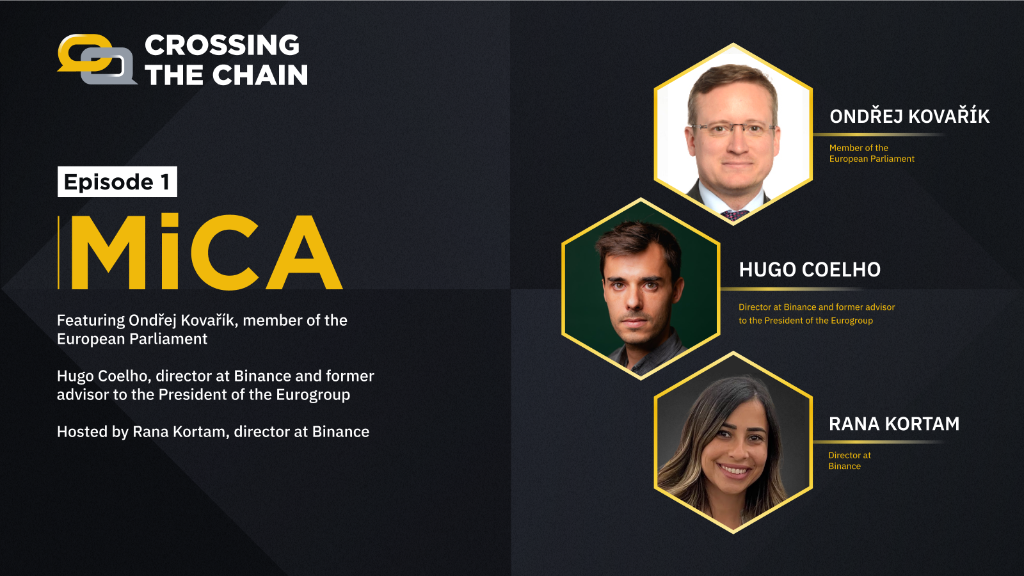Binance's Crypto Policy podcast discusses the EU's MiCA framework
Staying informed about evolving crypto policies and regulations is crucial for individuals involved in digital assets. Binance aims to educate users on important crypto regulations and has launched a podcast called "Crossing the Chain." This podcast will feature insights from global experts on policy and regulations in a user-friendly format.
The first episode of "Crossing the Chain" focused on the Markets in Crypto-Assets (MiCA) framework implemented by the European Union. It featured Ondřej Kovařík, a Member of the European Parliament involved in the creation of the legislation, and Hugo Coelho, the Director of Government Affairs at Binance.
The pace of policy and regulatory developments in the digital asset space is rapid. While some crypto users may think that these topics are irrelevant to them, understanding crypto regulation is increasingly important for anyone who owns or transacts in digital assets.
At Binance, we are dedicated to equipping users with the knowledge they need to thrive in a Web3-enabled future. Educating the community on digital asset regulation is a significant focus for us. As part of this effort, we are launching "Crossing the Chain," a podcast that will provide insights from top experts in policy and regulations in the crypto space.
The inaugural episode, hosted by Rana Kortam, Director of Public Policy at Binance, delved into the landmark Markets in Crypto-Assets (MiCA) framework recently adopted by the European Union. Ondřej Kovařík, directly involved in crafting the legislation as a Member of the European Parliament, and Hugo Coelho, Director of Government Affairs at Binance, shared their perspectives on MiCA and its impact on shaping global regulations. You can watch the full episode here or continue reading for a summary of the discussion.
"Crossing the Chain: Crypto Policy Podcast. EP01: Unpacking MiCA and How It’s Shaping the Global Regulatory Landscape."
Three Years in the Making
MiCA is a comprehensive crypto framework that establishes rules for digital asset issuers and service providers. It is the first framework of its kind to be adopted by a major jurisdiction. The legislative process for MiCA took nearly three years, and it was officially published on June 9, 2023. It will come into force on June 29, 2023, and full implementation is expected by 2025.
Ondřej Kovařík provided an introduction to MiCA, explaining that it regulates various digital assets, sets rules for market operators and service providers, and includes provisions for digital tokens. The framework enhances consumer protection, builds trust in the sector, and introduces a licensing regime that allows passporting of the license throughout the EU market.
The discussion covered the development of MiCA, with the proposal taking shape in September 2020 and undergoing around two years of work on the initial draft, followed by ten months of translation and refinement. The focus was on investor protection and alignment with existing anti-money laundering (AML) legislation. Establishing a framework for stablecoins, referred to as "asset-referenced tokens" in the legislation, was particularly challenging due to discussions coinciding with the collapse of the Terra ecosystem and its stablecoin, UST.
What Can We Expect in Practice?
Hugo Coelho explained the specific changes that MiCA will bring, including the obligation for issuers to provide a standardized whitepaper and be accountable for its content. Exchanges will face regulations to prevent market manipulation, and custody rules will protect client assets in case of insolvency. Industry players will need to make operational changes, such as reviewing the coins and products they offer and implementing appropriate systems and controls over the next 18 months.
Looking ahead, Kovařík mentioned that the provisions of MiCA will be implemented in stages, with most of them taking effect in late 2024 and early 2025. The real test will be the robustness of the licensing process, and secondary legislation will be required to clarify how the provisions apply in practice. Certain areas, such as NFTs or DeFi, are not covered by MiCA, and the European Commission will address these topics separately.
Next Steps
When asked about the global influence of MiCA, Kovařík stated that it has the potential to inspire other jurisdictions to adopt similar rules, but successful implementation is crucial for driving this process. Coelho added that while other jurisdictions may not directly copy MiCA, regulators worldwide are already working on comparable frameworks.
The discussion also touched on other regulatory developments, such as AML and counter-terrorism financing (CTF) crypto rules, taxation considerations, and provisions for payment services. MiCA sets limits for these rules and serves as a benchmark for aligning other regulations.
Regarding the future, Kovařík indicated that there won't be an immediate "MiCA-2" covering areas of digital finance not addressed by the current legislation, but one might be expected towards the end of the decade. He emphasized the importance of using the time before MiCA's implementation to foster a dialogue between the industry and regulators, ensuring a clear understanding of the rules. After all, the real work of putting this ambitious and groundbreaking set of rules into practice has only just begun.
Source: Binance

